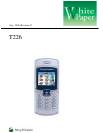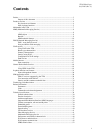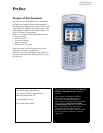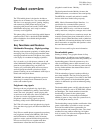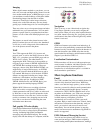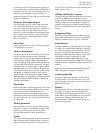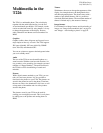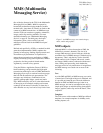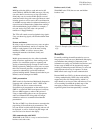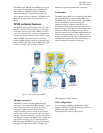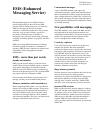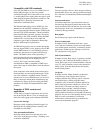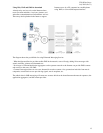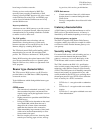
T226 White Paper
July 2003 (Rev C)
8
MMS (Multimedia
Messaging Service)
One of the key features in the T226 is the Multimedia
Messaging Service (MMS). MMS is expected to
become the preferred messaging method of mobile
terminal users, since there are virtually no limits to the
content of an MMS transmission. An MMS message
from the T226 can contain text, graphics, animations,
images, audio clips and ring melodies. For more
detailed information, see “Multimedia Messaging
Service” on page 45. For third-party developers’
information, please visit www.Ericsson.com/
mobilityworld/ and look for the MMS Developers’
guidelines.
Defined and specified by 3GPP as a standard for third
generation implementation, MMS completes the
potential of messaging. Sending digital postcards and
PowerPoint-style presentations is expected to be
among the most popular user applications of MMS.
Eagerly awaited by young users in particular, MMS is
projected to fuel the growth of related market
segments by as much as forty percent.
Using the Wireless Application Protocol (WAP) as
bearer technology and powered by the high-speed
transmission technologies such as GPRS, Multimedia
Messaging allows users to send and receive messages
that look like PowerPoint-style presentations. The
messages may include any combination of text,
graphics, photographic images, speech and music
clips. MMS eventually will serve as the default mode
of messaging on all terminals, making total content
exchange second nature. From utility to sheer fun, it
offers benefits at every level and to every kind of user.
MMS objects
Although MMS is a direct descendant of SMS, the
difference in content is dramatic. The size of an
average SMS message is about 140 bytes, while the
maximum size of an MMS message is limited only by
the memory. That is why the key word to describe
MMS content is rich. Complete with words, sounds
and images, MMS content is endowed with the user’s
ideas, feelings and personality. And whether the
messages are full or only notifications is insignificant.
An MMS message can contain one or more of the
following:
Text
As with SMS and EMS, an MMS message can consist
of normal text. The length of the text is unlimited, and
it is possible to format the text. The main difference
between an EMS and MMS message is that in an
MMS message, text can be accompanied not only by
simple pixel images or melodies but by photographic
images, graphics, audio clips and in the future, video
sequences.
Templates
The T226 comes with a number of MMS pre-defined
templates, for example templates for birthday cards,
meeting requests, etc.
Figure 1. An MMS message can contain images,
music, audio and graphics.



